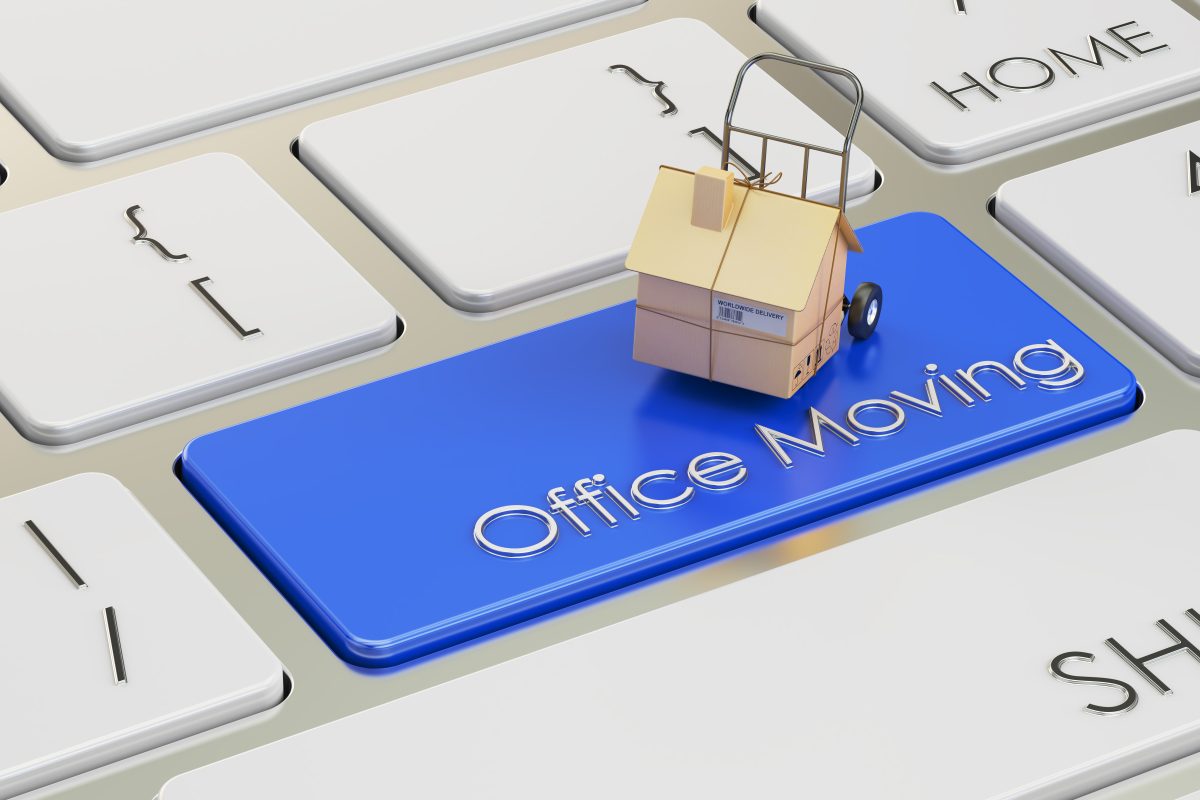In today’s business environment, office relocations and office closures are becoming more common. Whether you’re moving to a new location, closing a branch, shifting to a remote workforce, or managing a temporary closure, each scenario presents challenges and possible approaches to consider. This office move checklist will walk you through all of the steps and considerations you need to make for a successful office transition.
What Are the Different Considerations When Moving Offices?
Moving an Office
The first step is to assemble a dedicated team responsible for overseeing the move. This team should include members from various departments like IT, HR, operations, and finance, and their collective expertise will make sure all aspects of the move go smoothly.
Clearly define the purpose and goals of your office relocation. Are you aiming to improve workspace efficiency, reduce costs, accommodate growth, or enhance your company’s image? Understanding your objectives will guide decision-making throughout the process and help measure the success of your move. You should also carefully estimate and manage the costs associated with the move. This includes not only the obvious expenses like hiring professional movers but also indirect costs like potential downtime, new equipment or furniture, and any renovations to be made at the new location. Develop a comprehensive budget that accounts for all these factors to avoid unexpected financial strain.
Closing an Office
Manage lease agreements and financial settlements carefully. Review your lease terms to understand your obligations and potential penalties for early termination, and negotiate with your landlord if necessary to minimize costs and ensure a smooth exit.
Develop a plan for disposing of or donating unwanted office equipment and assets. This might involve selling furniture, donating to local charities, or redistributing items to other company locations. Proper asset management can also help your business recover some costs and salvage value in items. Before handing over the keys, conduct a thorough final walkthrough to ensure the office is left in good condition. This will help avoid disputes with the landlord and protect your security deposit. Document the condition of the space with photos or videos as evidence.
Closing a Branch
Develop a comprehensive communication plan to inform clients, suppliers, and employees about the closure. Be transparent about the reasons for the closure, how it will affect the relevant stakeholders, and provide clear information about how business will continue and any changes in points of contact.
Carefully catalog and redistribute branch assets. This might involve transferring equipment to other locations, selling assets, or storing items for future use. Ensure that valuable resources are not lost in the process of closing the branch. Maintain thorough records of the closure process. This includes financial records, communication logs, and asset disposition details. Good record-keeping is crucial for future reference, audits, and learning from the experience for potential future branch closures.
Shifting to a Remote Workforce
As more businesses embrace remote work, transitioning from a physical office to a distributed team requires careful planning. Ensure that your employees have remote access to all necessary systems and data. This may involve setting up virtual private networks (VPNs), cloud-based storage solutions, or remote desktop capabilities. Security should be a top priority to protect sensitive company information.
Implement effective communication and collaboration platforms. Tools like video conferencing software, project management systems, and instant messaging applications are essential for maintaining team cohesion and productivity in a remote environment.
Provide resources and support for employees transitioning to remote work. This might include ergonomic home office equipment, training on remote work best practices, and guidelines for maintaining work-life balance in a home environment.
Temporary Office Closure
Develop a comprehensive plan for the temporary shutdown and subsequent reopening. This should include timelines, responsibilities, and contingency plans for various scenarios. Identify and maintain critical services and operations during the closure as well. This might involve setting up temporary workspaces or implementing remote work solutions for essential staff.
Keep all stakeholders informed about the temporary closure and plans for reopening. Provide regular updates to employees, clients, and partners to maintain trust and minimize disruption to business relationships.
Timeline for Moving Offices
A successful office move requires careful planning and execution. Here’s a general timeline to guide your relocation process:
Pre-Move Planning (6-12 months before the move)
Review Leases and Set Budget: Begin by assessing your current lease agreement and establishing a realistic budget for the move. Consider all potential costs, including new lease terms, moving services, new furniture or equipment, and potential business interruption.
Form a Moving Team and Assign Responsibilities: Identify key team members from various departments to oversee different aspects of the move. Clearly define roles and responsibilities to ensure nothing falls through the cracks.
Secure New Office Space and Solidify Moving Dates: Once you’ve identified a suitable new location, negotiate lease terms and confirm your moving dates. Having concrete dates will help structure the rest of your planning process.
Mid-Planning (3-6 months before the move)
Contact Moving Companies and Gather Quotes: Research professional moving companies that specialize in office relocations. Obtain detailed quotes from multiple providers to ensure you’re getting the best value for your budget.
Communicate with Stakeholders and Employees: Begin informing all relevant parties about the upcoming move. This includes employees, clients, suppliers, and any other stakeholders who may be affected. Provide regular updates as the process unfolds.
Plan IT Setup and Inventory Management: Work with your IT department to plan the setup of technology infrastructure at the new location. Simultaneously, start inventorying office equipment and furniture to determine what will be moved, replaced, or discarded.
Final Preparations (1-3 months before the move)
Decommission Old Office and Update Business Addresses: Start the process of closing down the old office. This includes updating your business address on all official documents, websites, and marketing materials.
Pack and Label Items: Begin packing non-essential items and clearly label all boxes and furniture for easy identification at the new location. Encourage employees to pack their personal items and workspaces.
Transfer Utilities and Services: Arrange for the transfer or setup of utilities, internet services, and any other essential services at the new office location. Confirm installation dates and times to ensure everything is operational when you move in.
Moving Day
Supervise Logistics: Have key team members present to oversee the moving process. They should be available to answer questions, direct movers, and handle any unexpected issues that arise.
Ensure Smooth Transition and Setup at the New Office: As items arrive at the new location, supervise the setup process. Ensure that furniture and equipment are placed according to the predetermined floor plan.
Post-Move
Settle into the New Office and Address Any Issues: In the days following the move, focus on helping employees acclimate to the new space. Address any issues or concerns promptly to minimize disruption to work processes.
Conduct a Post-Move Review and Feedback Session: After settling in, gather feedback from employees and stakeholders about the move process. Use this information to evaluate the success of the relocation and identify areas for improvement in future moves.
Relocating Checklist for Business
To have a smooth and efficient office move, use this comprehensive office move checklist to guide your process:
Contracts and Agreements
Review and Update: Carefully examine all contracts and agreements to ensure they reflect your new office address. This includes:
- Lease agreements
- Insurance policies
- Vendor contracts
- Client agreements
- Employee contracts (if location-specific)
Legal Compliance: Verify that all aspects of your move comply with legal and regulatory requirements. This may involve:
- Updating business licenses and permits
- Ensuring compliance with local zoning laws
- Reviewing and updating any location-specific tax obligations
Communication Plan
Internal Communication:
- Develop a comprehensive communication strategy to keep employees informed throughout the moving process.
- Hold regular meetings or send updates to discuss the move’s progress and address any concerns.
- Provide clear instructions on employees’ roles in the move, including packing personal items and preparing workstations.
- Create a FAQ document to address common questions and concerns.
External Communication:
- Notify clients, suppliers, and other stakeholders about the relocation well in advance.
- Update your company website, social media profiles, and online directories with the new address.
- Consider sending out a formal announcement or press release about the move.
- Prepare a communication template for employees to use when informing their contacts about the new location.
Mail Forwarding and Mail Handling
Forwarding Services:
- Set up mail forwarding services with the post office to make sure no important correspondence is missed.
- Consider using a service like US Global Mail to manage the transition seamlessly and provide access to all of your mail virtually.
Change Notifications:
Create a comprehensive list of all entities that need to be notified about your new address, including:
- Government agencies (IRS, state tax authorities, etc.)
- Banks and financial institutions
- Professional associations and memberships
- Subscriptions and periodicals
Assign team members to update each category of contacts to ensure nothing is overlooked.
Packing (Operational Focus)
Inventory Management:
- Create a detailed inventory of all office assets, including furniture, equipment, and supplies.
- Decide what will be moved to the new office, what will be sold or donated, and what needs to be replaced.
- Use a robust inventory management system or spreadsheet to track items throughout the move.
Secure Packing:
- Provide employees with guidelines for packing their personal items and workstations.
- Use color-coded labels or a numbering system to identify which items go to which areas in the new office.
- Ensure that sensitive documents and valuable equipment are packed securely and transported separately if necessary.
- Create a system for labeling boxes that includes the department, contents, and destination in the new office.
Setting Up Your New Office
Workspace Setup:
- Develop a detailed floor plan for the new office, considering factors like workflow, collaboration spaces, and employee preferences.
- Coordinate with IT and facilities teams to ensure proper setup of workstations, including power and network connections.
- Plan the layout of common areas, meeting rooms, and specialized spaces (e.g., server rooms, break areas) to maximize efficiency and comfort.
IT and Telecom Setup:
Work closely with your IT department or provider to plan and execute the technology setup, including:
- Network infrastructure (routers, switches, Wi-Fi access points)
- Phone systems and conference room equipment
- Printers and other shared devices
Conduct thorough testing of all systems before the official move-in date to identify and resolve any issues, and make sure to provide employees with clear instructions on accessing and using new or updated systems in the new office.
Business Continuity from Old Address
Minimizing Downtime:
- Develop a strategy to maintain critical business operations during the move. This may include:
- Staggering the move over multiple days or weekends
- Setting up temporary workstations for essential staff
- Implementing remote work options during the transition period
- Communicate clearly with clients about any potential service interruptions and how you plan to mitigate them.
Interim Solutions:
- If necessary, set up temporary workstations or a satellite office to maintain operations during the move.
- Consider using co-working spaces or serviced offices as a short-term solution to bridge any gaps in service.
- Ensure that key employees have the tools and access they need to work remotely during the transition period.
By following this moving checklist for business, you’ll ensure that all of the important aspects of your office move are addressed. Hopefully this helps you minimize disruption to your business operations and smoothly transition to your new location. Remember, the key to success lies in thorough preparation, clear communication, and a focus on maintaining business continuity throughout the transition. Whether you’re moving to a new location, closing a branch, or adapting to a remote work model, this approach will help usher in a successful change for your organization.
Consider leveraging professional services to support your move. From specialized moving companies to mail management solutions, expert assistance can make a substantial difference in the efficiency and success of your office relocation.







